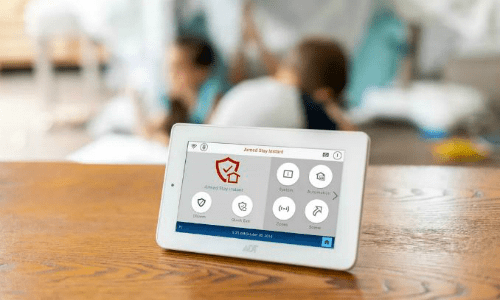
8.7.20 – SSI
ADT Command panels are powered by the Alarm.com platform. With Google’s arrival, Alarm.com’s CEO discussed the relationship during a Q2 earnings call.
As the dust settles in the wake of this week’s big news — Google acquiring a thin slice of ADT pie — one of the implications to play out going forward will be Alarm.com’s significant relationship with ADT.
In January 2019, the security industry bellwether chose the hot lights of CES to unveil ADT Command, the alarm and automation panel, along with ADT Control, the corresponding app. Although later commonly known, what didn’t resonate when the curtain first lifted on the new offering was that the Alarm.com platform powers the self-contained wireless system.
The collaboration is flourishing. More than three million customers are serviced by Alarm.com and ADT. (Resideo has a multiyear agreement to manufacture Command panels and other devices for ADT. The topic was only briefly addressed this week during Resideo’s Q2 earnings call.)
A recap on the week’s big news: Google will invest $450 million for a 6.6% stake in ADT, and in exchange it will receive access to about 6.5 million ADT customers to drive sales of Nest-branded products. ADT, meanwhile, will get the backing of a tech titan as it competes against multiple disruptors in the security and smart home space.
Deep integrations, machine learning and analytics; a lot is in the innovation thought pipeline and on the way from this “ADT + Google” pairing. Eventually. Meantime, it’s only natural that industry pundits and professionals are wondering what may become of the Alarm.com-ADT partnership. After all, in particular for Wall Street’s interest, there are bottom lines to scrutinize.
And so during Alarm.com’s Q2 earnings call with investors this week, President and CEO Steve Trundle addressed the topic and provided some additional insights. Spoiler alert: it’s (immensely) early in the game, folks.
Still, the burning question is what might Google’s arrival on the ADT scene mean for Alarm.com? Trundle provided his company’s perspective during the outset of the earnings call.
“ADT has indicated to me that it is Day One for this initiative and they are working to further develop a view of both the initial objectives and their longer-term plans. We believe that ADT continues to view Alarm.com as a strategic partner,” he said.
Makes sense. When the two companies first began collaborating on the ADT Command/Control project it was decided the security and automation system would be built from the ground up to best leverage Alarm.com’s existing platform and technological roadmap.
This has provided ADT a single platform with IoT application services for range of market verticals including residential and multifamily housing, small business and commercial properties, and DIY. The expectation is the two companies will continue to support and expand the deployment of ADT Command for the foreseeable future.
“We have a lot of competence and capability that I think will be valued as we look forward. So we’re looking forward to a set of discussions and a roadmap planning session in the not-too-distant future and we’ll see where things go,” Trundle commented. “It may be that we see some additional devices and whatnot integrated. But I think it’s a little early to tell exactly how that washes out.”
During the call an analyst posited the threat to Alarm.com could be that Google at some point may build a back-end system for dealers that is comparable to its own robust, technology-rich platform. In contrasting Google’s current smart home service capabilities vs. the Alarm.com platform, Trundle emphasized pedigree.
Since 2004, he said, the company has been focused first and foremost on the customer — the professional service provider — and building out the back-end application software that allows authorized dealers to manage a very large deployment when they themselves oftentimes have multiple dealers.
“So there’s a lot of application where that’s required that probably half of what we produce is not directly in front of the consumer,” Trundle said.
He continued, “Certainly, when we get into commercial applications as well, we get into very rich login hierarchies and permissioning routines and whatnot that you have to do. We wouldn’t have done them if we were just getting started in the past few years.”
Google’s forte is on the consumer hardware side, Trundle said, with elegantly designed devices that are rich in functionality and, in some cases, market-shifting. To date the company’s smart home focus has not been on rendering a platform to support professional service providers.
Regardless of Google’s strategic plans for engineering a smart home services platform, Trundle said competition is a good thing because it drives the need for innovation.
“And we’re in a position where we’re laying in place investments to maintain a very innovative posture,” he said. “So if you want to stay current and deliver the consumer a Tier 1 experience, I hope and I think that we are the right partner for you and that it will, regardless of how things shake out, that competitive technology environment will be good for Alarm.com.”
